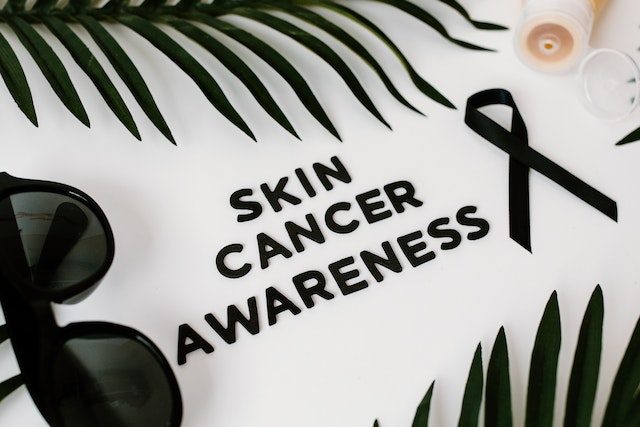
Do you know what you need to do to screen for skin cancer?
If not, this post will help!
What Is Skin Cancer?
According to the Skin Cancer Foundation, one out of five Americans will develop skin cancer by the age of 70.
In general, skin cancer is when DNA damage triggers out-of-control growth of abnormal skin cells in the outermost layer. This growth can cause malignant tumors.
There are four main types of skin cancer.
Basal Cell Carcinoma (BCC)
This is when abnormal, cancerous growths arise from the skin’s basal cells in the outermost layer of the skin (epidermis). These cancers usually show up on areas of the skin that are regularly exposed to the sun, like the face, ears, neck, scalp, shoulders, and back.
BCC is the most common form of skin cancer, and is typically curable, particularly when caught early.
Squamous Cell Carcinoma (SCC)
This is when abnormal squamous cells in the outermost layer of the skin start to grow uncontrollably. These cancers also show up in areas of the skin that are regularly exposed to the sun.
SCC is the second most common form of skin cancer. When caught early, it’s usually curable.
Melanoma
This cancer develops from melanocytes, the skin cells that produce melanin pigment. Melanin gives the skin its color. Melanomas look like moles and can appear on any area of the body, even those not typically exposed to the sun. They’re often triggered by intense, intermittent sun exposure that leads to sunburn.
Melanoma is the most dangerous form of skin cancer. It can be cured when caught early. If not treated in its early stages, it can spread to other organs and may be deadly.
Merkel Cell Carcinoma
This is a rare, aggressive form of skin cancer. It forms tumors that appear as firm, painless lesions or nodules on a sun-exposed area of the skin. It often shows up on the head and neck, and frequently on the eyelids.
MCC is dangerous and comes with a high risk of recurrence and metastasizing, often within two to three years after initial diagnosis. It is 40 times more rare than melanoma.
When Should I Screen for Skin Cancer?
Skin cancer can be serious, but the good thing is that it’s one of the easiest cancers to treat when caught early.
The other good thing is that you can detect these cancers yourself if you regularly check your skin. Being familiar with what your skin looks like and any unusual changes that happen can help you be proactive when it comes to your health.
The Memorial Sloan Kettering (MSK) Cancer Center recommends that you check your skin once a month. Look for skin spots or moles that are new or changing. This can help you discover any possible problems early.
What’s Involved In A Skin Self-Exam?
Start by getting a hand mirror. Then, undress and stand in front of a large, full-length mirror.
Slowly and carefully check every area of your skin. Remember that cancer can form anywhere, even on areas that aren’t normally exposed to the sun.
In general, you’re looking for anything that seems abnormal. Early skin cancer cells can look like any of the following:
- Scaly, crusty, and rough
- Flat patches of skin
- Irregularly shaped moles or raised areas
- A mole or bump that bleeds
- Moles that have changed color, shape, or size
- New growths or bumps
- A rash that doesn’t go away
- A wart-like growth that is changing
- Skin tags that bleed or itch
You can also follow the ABCDEs of melanoma. Look for anything that is:
- Asymmetric: The two halves of the mole do not match.
- Border: The borders are uneven.
- Color: There are several different shades (brown, black, tan, etc).
- Diameter: Melanomas are usually larger in diameter than the eraser on a pencil.
- Evolving: The area is changing in size, shape, and color, or is bleeding or crusting.
If you see anything like this that concerns you, make an appointment with your dermatologist for a medical screening.
A Step-by-Step Approach to a Self-Exam
Start with your face, ears, and chest. Then go to your belly. Women should lift their breasts and examine the skin underneath them.
Next, move to your arms and hands. Make sure to bend your elbows and check underneath, look at your armpits, check the back of your arms, and examine each finger.
Next, sit down and check your legs, knees, thighs, calves, and shins. Don’t forget the back side of your legs. Use your hand mirror and the large mirror to see them if you need to.
Next, move to your feet. Check the top, between the toes, and the soles. Make sure your fingernails and toenails look healthy, as some cancers can develop under the nails.
Now look at your neck and scalp. Push your hair aside to examine all areas of the scalp. You may need a partner to help you. Finally, check your buttocks and back, along with the genital area.
It’s also a good idea to check inside your mouth. Look for any white patches or black spots on the gums, roof of the mouth, underneath the tongue, or inside your cheeks.
Do I Need to Screen for Skin Cancer with a Dermatologist?
Recommendations vary on getting screened for skin cancer.
The U.S. Preventative Task Force, which regularly sets standards for cancer screenings, has concluded that the current evidence “is insufficient to assess the balance of benefits and harms of visual skin examination by a clinician to screen for skin cancer in adolescents and adults.”
The MSK Cancer Center agrees, noting that self-exams are sufficient for people at normal risk. If you are at high risk for skin cancer, however, annual exams with your dermatologist are a good idea.
The American Cancer Society (ACS) does not have guidelines for early detection of skin cancer either. They recommend knowing your skin. They also note that regular skin exams with a doctor are important for people who are at high risk, such as those with reduced immunity, who’ve had skin cancer before, and who have a strong family history of skin cancer.
The Skin Cancer Foundation, however, recommends annual screening with a dermatologist once a year for everyone, and more often for those at higher risk.
Risk factors include:
- A family history of melanoma in two or more relatives related by blood.
- Many moles or atypical moles.
- Many actinic keratoses spots (these are precancerous lesions that appear like gray or pink scaly patches).
- A personal history of many basal cell or squamous cell skin cancers.
What Happens During a Skin Cancer Screening Appointment?
If you go to a doctor for a skin cancer screening, you’ll remove your clothes and put on a medical exam gown. Usually, you don’t have to remove your underwear unless you have a spot on your genitals that concerns you.
Your doctor will thoroughly check your skin from head to toe. Some use a small handheld magnifying device that helps them see the layers of the skin just under the surface.
If the doctor notices anything suspicious, he or she may order a biopsy. That requires removing part or all of the lesion and sending it to the lab for testing. If the results show that the spot is cancerous, your doctor will advise you on the next steps.
Screen for Skin Cancer to Protect Yourself
Remember that with skin cancer, early detection is key. Motivated by my personal experiences with cancer, I know all too well how important early detection is. The sooner you find any suspicious areas, the higher your odds of being able to treat them, often with minimally invasive treatments.
CV Skinlabs was born from a need to provide safe and effective skin care solutions for those going thru cancer treatments. It’s part of our company mission to help support the organizations that are working hard to help prevent cancer, provide comfort, and raise awareness. Read more about how we give back here.
Do you regularly screen for skin cancer?
Featured images by Andrea Piacquadio via Pexels.




